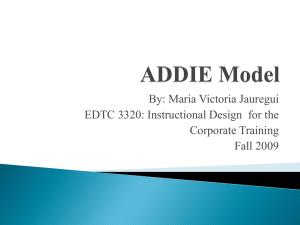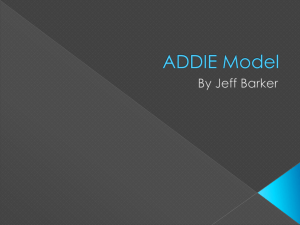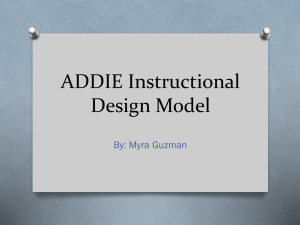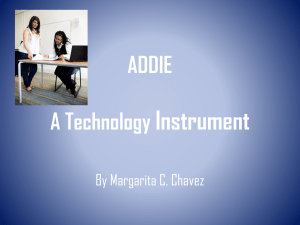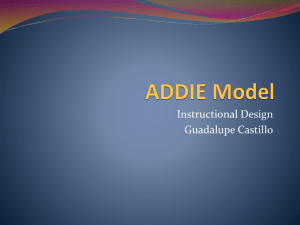The Addie and Arc Model
advertisement
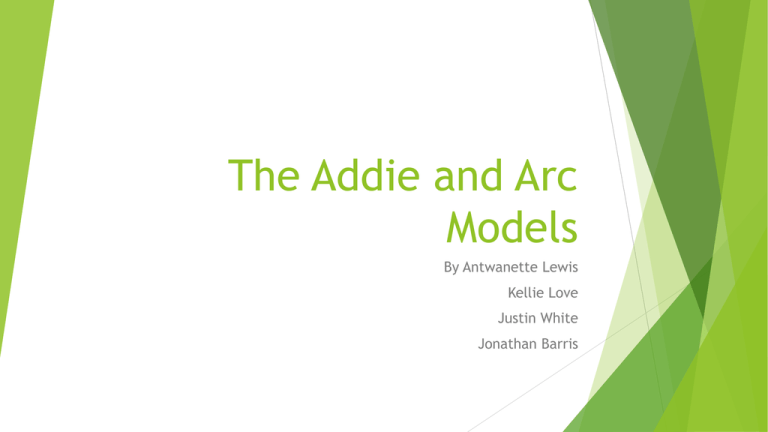
The Addie and Arc Models By Antwanette Lewis Kellie Love Justin White Jonathan Barris THE ADDIE MODEL BRIEF HISTORY ADDIE MODEL is a model of the Instructional System Design (ISD). ADDIE MODEL first appeared in 1975. It was created by the Center for Educational Technology at Florida State University for the United States Army. It was quickly adapted by all the United States Armed Forces. As defense machinery became more sophisticated, educational background of entry level soldiers became low. The potential solution to this problem was finding a form of systems approach to training. The Army chose this model. The ADDIE MODEL is specifically orientated towards the use of behavioral performance objectives and criterion-referenced tests. ADDIE MODEL The ADDIE MODEL consists of five phases: Analysis: In this phase, the designer identifies the learning problem, the goals and objectives, the audience’s needs, learning environment, any constraints, delivery options, and time limit. Design: In this phase, the designer identifies the specific learning objectives; storyboards and other materials are made; and strategies for teaching, resources, and assessments are determined. ADDIE MODEL Development: In this phase, the creation of content and learning materials Implementation: In this phase, the plan is put into action and a procedure for training the learner and teacher is developed. Students will have access to the materials needed. Evaluation: In this phase, there are two parts: formative and summative Formative evaluation: present in each stage of the ADDIE process Summative evaluation: consists of tests designed for criterion-related referenced items and providing opportunities for feedback from users. USES of the ADDIE MODEL The best use of the ADDIE MODEL is to use for training situations where things do not typically change in the process. ADDIE MODEL allows for perfection of a system. The ADDIE MODEL would work well for: long term, open ended projects company training an employee Teachers who want to develop a “unit of study” STRENGTHS and WEAKNESSES of ADDIE MODEL STRENGTHS: Helps show weaknesses in concepts or processes Provides feedback from learner to allow for revisions Effective for training type situations Encourages a “perfected” system WEAKNESSES: Not a model, but a framework Not flexible; Does not allow you to add in lessons or ideas as they present themselves All of the steps have to be known and items you want to cover before implementing the project or wait until the next time it is implemented. Could take a lot of time to create and implement VIDEOS of ADDIE MODEL BRIEF HISTORY The ARCS MODEL was created by John Keller. The ARCS MODEL is a method for improving motivational appeal of instructional material. The ARCS MODEL suggests that learning occurs effectively when learners are engaged throughout the entire learning process, and when strategies can be put in place to ensure that goes forward to completion. The ARCS MODEL can help with the following elements that affect motivation: Materials used Teacher behaviors Lesson structures that call for certain actions at the beginning, middle or end of the lesson Overall structure of the course with a variety of units and lessons THE ARC MODEL ARCS MODEL The ARCS MODEL has 4 categories: Attention: Material must grab the learner’s attention Use specific, relatable examples, create surprise, take a novel approach, use humor if appropriate Ask questions, brainstorm, role-play, use hands-on experience Incorporate different materials such as web based, video, field trips Relevance: Material must matter to them Explain how the lesson will benefit the learner Identify the learner’s needs and reasons for learning, and give options to accommodate them Connect the learning to the learner’s life, experiences, and values ARCS MODEL Confidence: Learners must believe that they can succeed Clearly outline what is expected of the students and the criteria for evaluation Give the learner choices and meaningful experiences to help facilitate successful learning Connect the learning with the student’s effort or personal ability Satisfaction: Learner must receive some sort of reward or reinforcement at the end of the learning experience Encourage and support the learner’s fundamental enjoyment of learning Provide positive reinforcement and motivational feedback Be consistent, not just within the framework of the assignment, but from one assignment to another USES OF the ARCS MODEL Designed as a global learning model to be effective both in the classroom and in professional learning environments. The model is fluent enough that it can be adapted to the level of the learners in the group and enough flexibility to be relevant at the type of learner and learning environments have evolved and changed. Keller’s suggestions of story-telling makes the materials relatable. STRENGHTS and WEAKNESSES of the ARCS MODEL STRENGHTS: Keeps the learner engaged for the duration of the learning experience Is an active learning model that encourages learner participation Is flexible and can be incorporated into a wide variety of learning experiences including training, professional development, and classroom regardless of whether the student is in regular education, special education, or higher education Continues to be relevant over time Easy to apply WEAKNESSES: May require the facilitator to completely re-think his or her approach to instruction Presents difficulties if there are learners of different levels of motivation in the group VIDEOS
